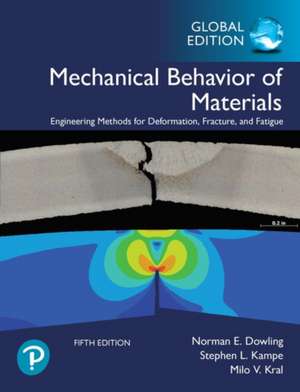Mechanical Behavior of Materials, Global Edition
Autor Milo Kral, Norman Dowling, Stephen Kampeen Limba Engleză Paperback – 13 aug 2019
Preț: 537.06 lei
Preț vechi: 617.32 lei
-13% Nou
Puncte Express: 806
Preț estimativ în valută:
102.78€ • 105.25$ • 85.50£
102.78€ • 105.25$ • 85.50£
Carte disponibilă
Livrare economică 25 februarie-11 martie
Livrare express 08-14 februarie pentru 58.51 lei
Preluare comenzi: 021 569.72.76
Specificații
ISBN-13: 9781292279350
ISBN-10: 1292279354
Pagini: 992
Dimensiuni: 181 x 233 x 35 mm
Greutate: 1.31 kg
Ediția:5. Auflage
Editura: Pearson Education
ISBN-10: 1292279354
Pagini: 992
Dimensiuni: 181 x 233 x 35 mm
Greutate: 1.31 kg
Ediția:5. Auflage
Editura: Pearson Education
Cuprins
1 Introduction
1.1 Introduction
1.2 Types of Material Failure
1.3 Design and Materials Selection
1.4 Technological Challenge
1.5 Economic Importance of Fracture
1.6 Summary
References
Problems and Questions
2 Structure, Defects, and Deformation in Materials
2.1 Introduction
2.2 Bonding in Solids
2.3 Structure in Crystalline Materials
2.4 Defects in Materials
2.5 Elastic Deformation and Theoretical Strength
2.6 Inelastic Deformation
2.7 Summary
References
Problems and Questions
3 Mechanical Testing: Tension Test and Stress-Strain Mechanisms
3.1 Introduction
3.2 Introduction to Tension Test
3.3 Engineering Stress-Strain Properties
3.4 Materials Science Description of Tensile Behavior
3.5 Trends in Tensile Behavior
3.6 True Stress-Strain Interpretation of Tension Test
3.7 Materials Selection for Engineering Components
3.8 Summary
References
Problems and Questions
4 Mechanical Testing: Additional Basic Tests
4.1 Introduction
4.2 Compression Test
4.3 Hardness Tests
4.4 Notch-Impact Tests
4.5 Bending and Torsion Tests
4.6 Summary
References
Problems and Questions
5 Stress-Strain Relationships and Behavior
5.1 Introduction
5.2 Models for Deformation Behavior
5.3 Elastic Deformation
5.4 Anisotropic Materials
5.5 Summary
References
Problems and Questions
6 Review of Complex and Principal States of Stress and Strain
6.1 Introduction
6.2 Plane Stress
6.3 Principal Stresses and the Maximum Shear Stress
6.4 Three-Dimensional States of Stress
6.5 Stresses on the Octahedral Planes
6.6 Complex States of Strain
6.7 Summary
References
Problems and Questions
7 Yielding and Fracture under Combined Stresses
7.1 Introduction
7.2 General Form of Failure Criteria
7.3 Maximum Normal Stress Fracture Criterion
7.4 Maximum Shear Stress Yield Criterion
7.5 Octahedral Shear Stress Yield Criterion
7.6 Discussion of the Basic Failure Criteria
7.7 Coulomb-Mohr Fracture Criterion
7.8 Modified Mohr Fracture Criterion
7.9 Additional Comments on Failure Criteria
7.10 Summary
References
Problems and Questions
8 Fracture of Cracked Members
8.1 Introduction
8.2 Preliminary Discussion
8.3 Mathematical Concepts
8.4 Application of K to Design and Analysis
8.5 Additional Topics on Application of K
8.6 Fracture Toughness Values and Trends
8.7 Plastic Zone Size, and Plasticity Limitations on LEFM
8.8 Discussion of Fracture Toughness Testing
8.9 Extensions of Fracture Mechanics Beyond Linear Elasticity
8.10 Summary
References
Problems and Questions
9 Fatigue of Materials: Introduction and Stress-Based Approach
9.1 Introduction
9.2 Definitions and Concepts
9.3 Sources of Cyclic Loading
9.4 Fatigue Testing
9.5 The Physical Nature of Fatigue Damage
9.6 Trends in S-N Curves
9.7 Mean Stresses
9.8 Multiaxial Stresses
9.9 Variable Amplitude Loading
9.10 Summary
References
Problems and Questions
10 Stress-Based Approach to Fatigue: Notched Members
10.1 Introduction
10.2 Notch Effects
10.3 Notch Sensitivity and Empirical Estimates of kf
10.4 Estimating Long-Life Fatigue Strengths (Fatigue Limits)
10.5 Notch Effects at Intermediate and Short Lives
10.6 Combined Effects of Notches and Mean Stress
10.7 Estimating S-N Curves
10.8 Use of Component S-N
1.1 Introduction
1.2 Types of Material Failure
1.3 Design and Materials Selection
1.4 Technological Challenge
1.5 Economic Importance of Fracture
1.6 Summary
References
Problems and Questions
2 Structure, Defects, and Deformation in Materials
2.1 Introduction
2.2 Bonding in Solids
2.3 Structure in Crystalline Materials
2.4 Defects in Materials
2.5 Elastic Deformation and Theoretical Strength
2.6 Inelastic Deformation
2.7 Summary
References
Problems and Questions
3 Mechanical Testing: Tension Test and Stress-Strain Mechanisms
3.1 Introduction
3.2 Introduction to Tension Test
3.3 Engineering Stress-Strain Properties
3.4 Materials Science Description of Tensile Behavior
3.5 Trends in Tensile Behavior
3.6 True Stress-Strain Interpretation of Tension Test
3.7 Materials Selection for Engineering Components
3.8 Summary
References
Problems and Questions
4 Mechanical Testing: Additional Basic Tests
4.1 Introduction
4.2 Compression Test
4.3 Hardness Tests
4.4 Notch-Impact Tests
4.5 Bending and Torsion Tests
4.6 Summary
References
Problems and Questions
5 Stress-Strain Relationships and Behavior
5.1 Introduction
5.2 Models for Deformation Behavior
5.3 Elastic Deformation
5.4 Anisotropic Materials
5.5 Summary
References
Problems and Questions
6 Review of Complex and Principal States of Stress and Strain
6.1 Introduction
6.2 Plane Stress
6.3 Principal Stresses and the Maximum Shear Stress
6.4 Three-Dimensional States of Stress
6.5 Stresses on the Octahedral Planes
6.6 Complex States of Strain
6.7 Summary
References
Problems and Questions
7 Yielding and Fracture under Combined Stresses
7.1 Introduction
7.2 General Form of Failure Criteria
7.3 Maximum Normal Stress Fracture Criterion
7.4 Maximum Shear Stress Yield Criterion
7.5 Octahedral Shear Stress Yield Criterion
7.6 Discussion of the Basic Failure Criteria
7.7 Coulomb-Mohr Fracture Criterion
7.8 Modified Mohr Fracture Criterion
7.9 Additional Comments on Failure Criteria
7.10 Summary
References
Problems and Questions
8 Fracture of Cracked Members
8.1 Introduction
8.2 Preliminary Discussion
8.3 Mathematical Concepts
8.4 Application of K to Design and Analysis
8.5 Additional Topics on Application of K
8.6 Fracture Toughness Values and Trends
8.7 Plastic Zone Size, and Plasticity Limitations on LEFM
8.8 Discussion of Fracture Toughness Testing
8.9 Extensions of Fracture Mechanics Beyond Linear Elasticity
8.10 Summary
References
Problems and Questions
9 Fatigue of Materials: Introduction and Stress-Based Approach
9.1 Introduction
9.2 Definitions and Concepts
9.3 Sources of Cyclic Loading
9.4 Fatigue Testing
9.5 The Physical Nature of Fatigue Damage
9.6 Trends in S-N Curves
9.7 Mean Stresses
9.8 Multiaxial Stresses
9.9 Variable Amplitude Loading
9.10 Summary
References
Problems and Questions
10 Stress-Based Approach to Fatigue: Notched Members
10.1 Introduction
10.2 Notch Effects
10.3 Notch Sensitivity and Empirical Estimates of kf
10.4 Estimating Long-Life Fatigue Strengths (Fatigue Limits)
10.5 Notch Effects at Intermediate and Short Lives
10.6 Combined Effects of Notches and Mean Stress
10.7 Estimating S-N Curves
10.8 Use of Component S-N
